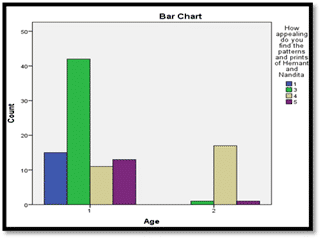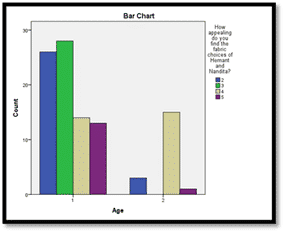International trends and cultural exchanges constantly impact design aesthetics in the dynamic and interrelated global fashion business. In this environment, designers are increasingly incorporating a wide range of global inspirations into their work and combining disparate components to produce unique looks that are universally recognisable. Renowned Indian designers Hemant and Nandita have become important characters in this story of globalised fashion. Their work is distinguished by a distinctive fusion of modern global trends with traditional Indian themes, producing a creative and culturally rich design aesthetic.
This study aims to investigate the international fashion influences that have greatly influenced Hemant and Nandita’s design aesthetic. The study intends to determine the international influences that have been introduced into their work and how these components interact with and improve their Indian background by looking at their collections and design philosophy. The examination will consider the larger background of worldwide fashion trends, cross-cultural interactions, and the influence of global markets on the creative output of the designer team.
Literature Review
Yakymchuk, D et al., (2017) carried out a study whose goal was to investigate how the inventive feminine Indian suit may serve as a model for apparel design in hospitality places. They examined academic journals and stylish, cutting-edge Indian designers’ feminine outfits using an analytical approach. The results show that contemporary Indian designers are progressively adding avant-garde elements to women’s apparel, fusing aspects of formal and casual attire, and emphasising audacious experimentation in their creations.
Chae, H., et al., (2016) sought to investigate how consumer participation in social networking services (SNS) affects customer equity for international fashion businesses with a focus on Louis Vuitton and Uniqlo. They polled 582 users of these brands’ social media accounts, most of whom were from Generation Y. The results emphasised the growing importance of customer participation in SNS for service marketing. According to the study, social media has changed consumer interaction, making it simpler and more voluntary. It also suggests that effective SNS engagement is now essential for success in the service sector.
Hernandez & Haddud (2018) aimed to examine value creation through supply chain risk management (SCRM) in global fashion organisations outsourcing production to China. They reviewed existing literature on SCRM and developed a model to quantify the impact of macro and micro risk factors on various operational performance indicators. This model was tested through a survey of 61 Chinese fashion manufacturers and interviews with 20 global supply chain members. The findings revealed that while traditional risks such as supply, manufacturing, and demand continue to impede value creation, other factors like macro-social and micro-infrastructure issues also significantly affect performance. The study also highlighted that the impact of these risks varies across performance indicators like quality, speed, cost, dependability, and flexibility. Additionally, it was found that current SCRM programmes are often simplified, rely on incomplete key performance indicators (KPIs), and are influenced by dominant stakeholders, leading to potential agency costs and a short-term focus.
Seifert & Chattaraman’s (2017) study was to find out how customers’ aesthetic sensitivity affects how complicated and new clothes designs are judged by them. With 260 female participants, they ran a mixed factorial experimental design where they varied the intricacy and uniqueness of the women’s top designs. The results showed that designs with a high level of intricacy and innovation were generally well-received by customers. On the other hand, designs with both low and low novelty or both high and low complexity were not as favoured as those that combined high and low novelty or low and high complexity. Furthermore, compared to consumers with low CVPA (Customer Value Perception Analysis), those with high CVPA were more discriminating in their preferences for novelty in clothing designs.
Ko, Kim et al., (2017) looked at lifestyle segments among female customers in the US, South Korea, and Europe that cut across cultural barriers. The research applied cluster analysis to determine lifestyle segments and employed a survey administered to individuals from these regions. Four international market segments were established by the research: conspicuous consumers, sensation seekers, information seekers, and utilitarian consumers. The results also showed that a consumer’s response to advertisements from a prominent international fashion brand that appeared in the US, France, and South Korea editions of Vogue was more heavily influenced by their fashion lifestyle category than by their nationality.
Objectives
The main objectives of the study are:
• To examine the design aesthetic of Hemant and Nandita in terms of patterns and prints, fabric choice, silhouette, colour palette and any other details.
• To analyse the dynamics of consumer global design aesthetic.
• To analyse how they incorporate streetwear influences in their collections.
• To understand the Bohemian styles in Hemant and Nandita designs.
• To study how minimalist designs are being incorporated in their collections.
Research Methodology
Data Collection Method
To gather information for the study of how Hemant and Nandita’s design aesthetic has been influenced by global fashion, brand collections, fashion shows, designer interviews, customer comments, and industry publications have been examined. The research method encompasses a quantitative approach based on the research objectives. It administered a structured questionnaire to collect data from the selected participants. Respondent data for this study was gathered via a Google form survey. The secondary data for this study was gathered using textbooks, scholarly journals, conference papers, news articles, and other sources.
Research Design
This study collected 100 samples using convenient sampling. It was able to reach 100 respondents because it was within the researchers’ reach, i.e., on the campus of the National Institute of Fashion Technology, Daman, and office colleagues.
The analysis involved the use of IBM SPSS statistical software for quantitative data analysis to identify patterns and correlations in fast fashion brands which claim to be sustainable. The close-ended, MCQ-based questions and five-point Likert scale were used because they produced stronger findings.
Hypotheses
H1: There is a significant relationship between age and how people perceive the patterns and prints of Hemant and Nandita.
H2: There is a significant relationship between age levels and the perceived appeal of the fabric choices of Hemant and Nandita.
H3: There is a significant relationship between age and how appealing do people find the colour palette of Hemant and Nandita.
H4: There is a significant relationship between the occupation of the people and how minimalist designs they prefer of Hemant and Nandita
H5: There is a significant relationship between the spending habits of the people and the influence of the streetwear designs of Hemant and Nandita.
Data Analysis
Correlation-1
H0: There is no significant relationship between age and how people perceive the patterns and prints of Hemant and Nandita.
H1: There is a significant relationship between age and how people perceive the patterns and prints of Hemant and Nandita.
Correlation between the age and how people perceive the patterns and prints of Hemant and Nandita.


Interpretation: The p-value obtained from the analysis is 0.011, which is less than the alpha value of 0.05. Since the p-value is less than the alpha threshold, we reject the null hypothesis. This means that there is statistical evidence to suggest a significant relationship between age and how individuals perceive the patterns and prints of Hemant and Nandita’s designs. In other words, people’s opinions on the patterns and prints their designs are influenced by their age, indicating that different age groups may have varying levels of appeal for these specific design elements.
Correlation-2
H0: There is no significant relationship between age levels and the perceived appeal of the fabric choices of Hemant and Nandita.
H1: There is a significant relationship between age levels and the perceived appeal of the fabric choices of Hemant and Nandita.
Correlation between the age levels and the perceived appeal of the fabric choices of Hemant and Nandita.


Interpretation: The p-value obtained from the analysis is 0.017, which is less than the alpha value of 0.05. Because the p-value is below the alpha threshold, we reject the null hypothesis. This indicates that there is a statistically significant relationship between age levels and the perceived appeal of the fabric choices offered by Hemant and Nandita. In practical terms, this means that individuals of different ages perceive the fabric choices differently. The appeal of these fabrics is not uniform across all age groups, suggesting that age has a meaningful impact on how the fabric choices are evaluated and appreciated.
ANOVA
H0: There is no significant relationship between age and how appealing do people find the colour palette of Hemant and Nandita.
H1: There is a significant relationship between age and how appealing do people find the colour palette of Hemant and Nandita.
Analysis of variants between age and how appealing do people find the colour palette of Hemant and Nandita.


Interpretation: The p-value obtained from the analysis is 0.009, which is less than the commonly used alpha value of 0.05. Since the p-value is lower than the alpha value, we reject the null hypothesis. This result indicates that there is a significant relationship between age and the perceived appeal of the colour palette used by Hemant and Nandita. People’s opinions on the colour palette of these designs vary significantly with age. This suggests that different age groups may have distinct preferences or reactions to the colour choices, highlighting that age influences how appealing the colour palette is perceived. The finding underscores the importance of considering age-related preferences when evaluating or designing colour palettes for a diverse audience.
Independent T-test-I
H0: There is no significant relationship between the occupation of the people and how minimalist designs they prefer of Hemant and Nandita
H1: There is a significant relationship between the occupation of the people and how minimalist designs they prefer of Hemant and Nandita

Interpretation: The p-value obtained from the analysis is 0.008, which is slightly above the commonly used alpha value of 0.05. Because the p-value is greater than the alpha threshold, we do not reject the null hypothesis in this case. This result suggests that there is not enough statistical evidence to conclude a significant relationship between occupation and the preference for minimalist designs by Hemant and Nandita. In other words, the data does not provide strong support for the idea that different occupations significantly influence individuals’ preferences for minimalist designs. Therefore, while there may be some variation in design preferences based on occupation, it is not statistically significant enough to assert a clear relationship between occupation and the preference for minimalist designs within this specific context.
Independent T-test-II
H0: There is no significant relationship between the spending habits of the people and the influence of the streetwear designs of Hemant and Nandita.
H1: There is a significant relationship between the spending habits of the people and the influence of the streetwear designs of Hemant and Nandita.

Interpretation: The p-value obtained from the analysis is 0.029, which is less than the alpha value of 0.05. Since the p-value is below the alpha threshold, we reject the null hypothesis. This indicates that there is a statistically significant relationship between spending habits and the influence of streetwear designs by Hemant and Nandita. This result suggests that individuals’ spending habits have a meaningful impact on how they are influenced by streetwear designs. For instance, people who spend more on fashion might have different reactions to or preferences for Hemant and Nandita’s streetwear compared to those with different spending patterns. The significant relationship implies that variations in spending behaviour are associated with varying levels of influence or appeal that streetwear designs have on individuals.
Suggestions
To conduct a thorough analysis of the global fashion influences on Hemant and Nandita’s design aesthetic, it is recommended to commence with an examination of certain collections and visual components that exemplify worldwide trends. In-depth case studies of collections shown in various regional markets or at international fashion weeks can provide examples of how global aesthetics are used. To further emphasise the blending of local and global influences, compare these aspects with traditional Indian motifs and provide a visual analysis to show how global patterns, colours, and materials were incorporated into their designs.
To have a better knowledge of how worldwide trends influence the brand’s design decisions, conduct interviews with prominent figures in the fashion industry, such as designers, critics, and trend analysts. Examine how digital platforms and social media have shaped and exposed the brand’s look to a worldwide audience. Examine how Hemant and Nandita modify their designs to suit various foreign markets, considering shifting customer trends and tastes.
To emphasise distinctive facets of Hemant and Nandita’s worldwide influence, compare, and contrast their methodology with those of other top Indian designers. Analyse how the current global sustainability trends have affected their design approach, taking note of any eco-friendly procedures and materials used. Use customer surveys to find out how people throughout the world see the brand’s designs. Fashion studies’ theoretical frameworks can be utilised to contextualise these influences, and studying the growth of their design aesthetic across time can reveal how international trends have influenced their contemporary look. This multi-pronged strategy will provide a comprehensive grasp of how Hemant and Nandita negotiate and incorporate international fashion trends.
Conclusion
Hemant and Nandita’s design approach seamlessly blends global fashion trends with traditional Indian elements, showcasing their ability to innovate while maintaining cultural authenticity. Their participation in international fashion weeks and strategic use of social media have significantly contributed to their global presence, enabling them to cater to diverse regional tastes and preferences. By striking a balance between global aesthetics and traditional craftsmanship, they have established a unique brand identity that resonates with both domestic and international audiences, offering valuable insights for designers and businesses seeking to establish themselves in the dynamic fashion industry.

20250117163420.png)







Comments